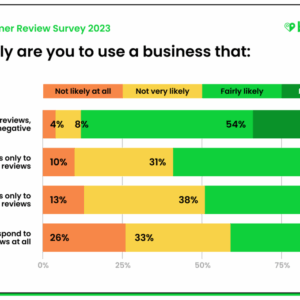

A business’ success is built around its reputation. When customers think positively of you, they come back for more and spread the word to friends and family. But to secure your business’ reputation, you must be aware of any risks that might impact it.
This is where reputation management comes in handy. The right approach can help you spot reputational risks early so you can prepare and mitigate the worst effects.
What is reputational risk?
Anything that damages your organization’s standing with its audience is classed as reputational risk. This might be bad reviews, negative comments on social media, or internal scandals.
If you leave these things unaddressed, it can quickly ruin your image, with customers having less trust in your business and your brand visibility diminishing. That’s why dealing with reputational risks as soon as possible should always be a priority.
Image sourced from brightlocal.com
Common types of reputational risks
Many different elements can damage your brand’s reputation. Let’s look at some of the different reputational risks that might impact your business.
- Social media backlash: Sometimes, social media posts don’t land the way you expect them to. In the worst-case scenario, a post may begin to attract negative attention that damages your brand.
- Disappointing products: When your products or services fail to deliver, customers are likely to voice their frustrations. Unfavorable posts and customer reviews can quickly snowball and leave a lasting impression on your brand’s reputation.
- Unfavorable media coverage: Negative content can be shared widely across social media. In the worst instances, it will impact customer loyalty, leading your audience to think twice about shopping with you again.
- Data breaches: Crises that impact customers directly will always damage your reputation. A data breach could result in the exposure of sensitive customer information and lead shoppers to lose trust.
- ESG Risks: What is ESG risk? The term applies to environmental, social, and governance risks. For example, any business activities that contribute to climate change would be classed as ESG risks.
Issues such as social equality are highly correlated with customer consciousness, and these risks pose a threat to customer interest.
- Compliance issues: Failure to comply with regulations can lead to your business appearing evasive. Customers may be less likely to trust your business and be wary of recommending you to other potential customers.
How does reputation management help?
Reputation management helps you gauge how your audience feels about your business. It involves monitoring mentions of your brand and your products across social media and various websites. It also includes looking at customer feedback to spot common complaints.
Effective reputation management helps you spot potential risks before they do too much harm. You can respond to negative comments by acknowledging an issue or correcting any misinformation.
You can dispel negative sentiments and own the narrative. That’s why reputation management should be included in every risk management framework.
The process can be handled entirely manually or with the help of online reputation management software. This will automate the monitoring process for you, freeing up staff to focus on other tasks—like crafting careful responses or acting on the feedback you’ve gathered.
The benefits of reputation management for risk mitigation
When implemented correctly, reputation management can be highly effective. Let’s explore some of the biggest ways this process helps reduce reputational risks.\
Builds stronger customer relationships
Reputation management improves your brand’s online presence. Having the right strategy in place ensures that you can identify and reply to comments online, whether they be positive or negative.
Effective reputation management is particularly important during events such as product launches. It can help to address negativity from customers who are unhappy about your offering, giving you a chance to address concerns and prove you’re on your customer’s side.
All this contributes toward a reputation for transparency and reliability, leading to better customer relations. Happy customers who trust your brand are more likely to stay with you and build a long-term relationship. They’ll also be inclined to share your products with friends and family.
Combats damaging misinformation
When your business doesn’t have a strong presence online, it’s harder to control the narrative. Troublemakers will fill the void with misinformation that paints your brand in a damaging light. Left unaddressed, these rumors can quickly spread and become harder to dispel.
Combining reputation management with an omnichannel contact center ensures that you can combat false information. Firstly, it guarantees that your brand is where it needs to be.
You’ll be reaching your audience on their preferred platforms. With strong control over the narrative, there’s less room for bad actors to spread rumors.
Improves your crisis response
A crisis can strike your business at any time without warning. When it does, you’ll want to be in control of an issue.
By offering clear assurances, you can put your audience at ease and protect your reputation. For this, however, you’ll need a strategy for communicating with your audience and responding to their concerns.
Reputation management enables you to keep your finger on the pulse during times of crisis. You can identify common concerns online and adapt your messaging to address them.
When customers share concerns via social media platforms, you can respond to their comments. All this gives a sense of being in control, ensuring that customers have faith in your approach.
Many online reputation management tools offer sentiment analysis, so you can also gauge your audience’s response to your crisis management strategy. These tools analyze customer comments to reveal whether they’re positive, negative, or neutral.
This information can be valuable for benchmarking; you can see how sentiment changes as you carry out your strategy.
Keeps employees happy
A successful business isn’t just about pleasing customers—you need to factor in employee happiness, too.
Negative sentiment from the press or public can lead team members to lose faith in their employer. They’ll feel less invested in working toward organizational success, and you’ll find it harder to hold onto your top talent.
In addition to conducting regular employee reviews, you can keep an eye on employee morale by monitoring brand mentions online.
Employees will feel happier working for an employer who takes steps to resolve problems rather than ignore them. Plus, satisfied employees are more likely to talk positively about your company, leading to a reputational boost.
Improve stakeholder relationships
Maintaining stakeholder relationships is critical for overall success. When your reputation suffers, stakeholders will be concerned about your ability to keep customers happy and see projects to completion.
Reputation management ensures that you’re working to maintain positive brand perceptions. You’ll find the best ways to engage your customers, meet their needs, and deliver quality products or services.
All this sends a positive message to your stakeholders, meaning they’ll be more committed to supporting your projects.
Reputation management best practices
Hopefully, we’ve enforced just how useful reputation management can be. But how can you ensure an effective strategy that helps you meet your unique goals? Below, we’ve listed some best practices to get your reputation management on the right track.
Respond to your audience
When customers leave comments, be sure to respond to them—even the really negative ones. It’s easy to avoid criticism and angry customers.
But by doing so, you leave comments to grow and fester. By responding to and acknowledging negativity, you prove to customers that you’re invested in providing the best possible experiences.
Have backups for your tech solutions
A simple hardware issue can prevent your business from conducting its day-to-day work. Customers may be unable to access important services, such as customer support. Utilizing platform as a service (PaaS) can help you avoid this scenario.
PaaS enables computing to be conducted on the cloud, vastly reducing the risk of downtime. Some platform as a service examples include Microsoft Azure and Amazon Web Services.
This is also why it’s important to have a voice across multiple channels. If your website is temporarily down or your phone line provider hits an issue, you can post about it elsewhere and keep your audience informed.
Create a plan for crisis communications
There’s no knowing when the next crisis will strike. You can, however, plan to mitigate the worst impacts of a crisis, protect your reputation, and facilitate smooth disaster recovery. One thing that escalates a problem to a catastrophe can be a lack of communication.
Customers don’t like feeling out of the loop, and if you can’t provide them with information, they’ll assume it’s because you’re not in control.
A crisis communication plan should include strategies, roles and responsibilities, and policies for enabling communication during a crisis. That way, even if resolving the problem takes time, customers know you’ve got things in hand.
Ensure strong financial oversight
Costly errors can prevent businesses from delivering the services customers expect. To ensure oversight, utilize reconciliation software and run regular financial audits. Make sure your business has clear financial planning procedures in place.
It’s particularly important to store any customer financial information securely and in compliance with local laws and regulations. This reduces the risk of data breaches or cases against you, encouraging potential customers to put their trust in you.
Give your business a reputation boost
Reputational risks pose a constant threat to your business. Luckily, reputation management can keep these issues in check and keep your audience happy.
From building stronger customer relationships and combating misinformation to improving your crisis response, this approach has a long list of benefits.
So, why not try our best practices as you put your reputation management strategy into place? With a positive reputation, you can pull in top talent, retain more customers, and secure your place in the market.
FAQs
What is reputation management?
Reputation management is the process of monitoring online channels for brand mentions. It allows businesses to understand and address common customer complaints. Through a proactive approach, businesses can secure their reputation and build strong customer relationships.
How does reputation management mitigate risks?
Effective reputation management enables you to respond to factors that might damage your reputation, such as negative feedback, bad press, or ethical issues.
A quick response to risks helps you to reduce their most damaging impacts. Additionally, having a strong reputation to start with gives you a little leeway if something does go wrong, as your audience is more likely to give you the benefit of the doubt.
Should you undertake reputation management manually or through automation?
While reputation management can be done manually, it’s incredibly time-consuming. Reading through every possible mention of a brand online can take a lot of time, not to mention how long it then takes to analyze the gathered information.
Instead, automating the gathering and analysis steps can free up your team for the most important part—the response.
Originally published May 22, 2025
Source link





No Comment! Be the first one.